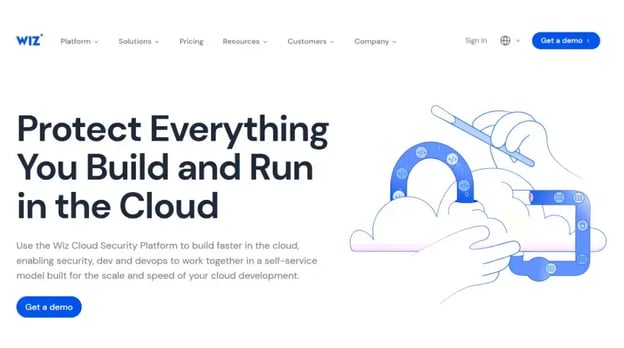Date: 29 July 2025
The 10 Best AI-Powered Cloud Security Tools
We ranked and rated these cloud security platforms based on several factors, including innovation, peer-reviewed customer experience, market presence, and AI capabilities.
1. Wiz

WIZ has quickly emerged as a leader in providing cloud security and is recognised for its agentless approach to providing continuity across complex multi-cloud environments. Rather than focusing on the risk of a single cloud app, Wiz focuses on the interconnectedness of cloud assets across multi-cloud environments, addressing vulnerabilities and misconfigurations that pose a risk of breaches for industries that need to do so.
It provides visibility across a multi-cloud environment without the need for agents, which substantially simplifies deployment and management. It excels at analyzing context, identifying high-severity risks, limiting false positives, and focusing security initiatives on the most significant issues.
Key Features
- Continuously scans cloud controls looking for cloud misconfigurations or compliance violations.
- Provides agentless vulnerability management, malware detection, and visibility into sensitive data exposure on workloads.
- Analyzes cloud identity and access management (IAM) permissions to find over-privileged or risky access.
- Employs a graph database to identify potential attack paths, enabling risk prioritization based on exploitability.
Best For: Organizations that want a powerful, easy-to-deploy, and user-friendly platform for all-around cloud risk management across varied cloud environments.
2. CrowdStrike Falcon Cloud Security
CrowdStrike Falcon Cloud Security, which is built on the brand's well-known endpoint expertise, delivers AI-powered protection from the endpoint to the cloud workload. It's a cloud-native and lightweight agent architecture. Falcon is often praised for its coverage, real-time threat protection, ease of deployment, and high stability.
Key Features
- Cloud-native, lightweight-agent design and architecture.
- Real-time threat protection and rapid deployment.
- Utilizes CrowdStrike's endpoint security expertise.
Perfect For: Organisations already embedded in the CrowdStrike ecosystem, or those seeking a mature, cloud-native security solution with a strong emphasis on endpoint integration.
3. Zscaler Cloud Security

Zscaler Cloud Security, especially Zscaler Internet Access (ZIA) and Zscaler Private Access (ZPA), delivers a cloud-native, AI-powered secure web gateway and zero-trust network access. It achieves this by eliminating perimeter security measures and simply connecting the user to the app, rather than the network.
Key Features
- Cloud-delivered security services (CASB, ZTNA, SWG).
- Zero Trust security architecture.
- Secure user access to cloud-based applications and the internet.
Best For: Organisations that need a strong zero-trust security model, want to secure access to the internet and SaaS applications, and are anxious to replace VPNs and perimeter-based security.
4. Palo Alto Network’s Prisma Cloud
Palo Alto Networks Prisma Cloud is an all-in-one cloud-native security platform that provides comprehensive lifecycle security and compliance for cloud-native applications in multi-cloud and hybrid environments. It incorporates AI, machine learning, analytics, and automation to secure apps from code to cloud and into production.
Key Features
- Next-generation Cloud Native Application Protection Platform (CNAPP).
- Deep security coverage across infrastructure, workloads, and applications.
- Deep visibility across multi-cloud deployments.
- Integrated AI-based prioritisation and automated remediation capabilities.
Perfect for: Large enterprises with complex, multi-cloud and hybrid environments that require an expansive, integrated security platform for comprehensive, end-to-end protection.
5. Aqua Security
Aqua Security offers a comprehensive cloud-native application protection platform (CNAPP) that secures applications throughout their entire lifecycle, from development to production. Aqua Security provides complete visibility and protection of containers, serverless, and various other cloud-native workloads.
Key Features
- Focus on protecting cloud-native applications (containers, Kubernetes, serverless)
- Cloud Security Platforms that cover the build, runtime, and infrastructure
- Good image scanner and good runtime protection
- Automated compliance for cloud-native environments.
Best For: Development and security teams focused on securing their cloud-native applications, primarily those with heavy reliance on containers and serverless, and looking for a strong form of protection across the entire application lifecycle.
6. Check Point CloudGuard

Check Point CloudGuard provides integrated cloud-native security services for public, private, and hybrid cloud environments. It combines advanced threat prevention capabilities, cloud workload protection, and cloud network security and is designed to integrate with leading cloud providers.
Key Features
- Vendor with a full suite of cloud security solutions.
- Its security model prioritises prevention.
- Automated secure code review.
- Intelligent enforcement of compliance policies.
Perfect For: Enterprises with multi-cloud or hybrid environments that want extensive centralised secure management and advanced threat prevention capabilities, leveraging existing Check Point solutions investments.
7. Orca Security

Orca Security offers an agentless cloud security platform that provides full visibility into an organisation's cloud estate. With its innovative SideScanning technology, the platform retrieves data straight from the runtime block storage in the cloud environment, providing coverage that cannot be impacted from a workload perspective.
Key Features
- Extracts real-time insights with "X-Ray vision".
- Offers immediate value with AI-driven analysis.
- Understands cloud sprawl instantly.
Perfect For: Organisations that value an agentless security solution allowing for quick deployment and visibility across their multi-cloud infrastructure while keeping operational overhead low.
8. Lacework FortiCNAPP

Lacework FortiCNAPP (Cloud-Native Application Protection Platform) offers a data-driven approach to cloud security, combining posture management, workload protection, identity security, and threat detection into a native, single platform. It uses AI-based anomaly detection and behavior analytics to monitor cloud environments continuously.
Key Features
- Cloud Security Platform (data correlation with Polygraph technology).
- Good analytics and visualisation.
- CNAPP capabilities (CSPM, CWPP, CIEM)
Perfect For: Organisations looking to adopt a data-driven CNAPP solution that delivers advanced visibility with embedded automated threat detection and anomaly-based monitoring utilising behavioural analytics across multi-cloud and containerized environments.
9. Trellix Cloud Security

Trellix (formerly McAfee Enterprise and FireEye) provides a comprehensive AI-driven security platform that spans endpoint, network, data, and cloud environments. Their cloud security capabilities emphasise defending cloud workloads and data with advanced detection and response capabilities enhanced through AI-guided investigations.
Key Features
- Extended Detection and Response (XDR) platform.
- Takes an integrated approach towards endpoints, networks, and clouds.
- Provides threat intelligence and advanced analytics.
Best For: Organisations looking for a single unifying security platform with robust AI-driven threat detection and response capabilities across their hybrid IT infrastructure, their cloud workloads, and their data.
10. Forcepoint Cloud Security

Forcepoint provides an AI-powered cloud-native security platform centered on protecting data and leveraging a Zero Trust model. Forcepoint Data Security Cloud is the central product that integrates data protection across cloud, web, and private applications within the enterprise, leveraging AI Mesh technology to classify data and orchestrate risk-adaptive controls.
Key Features
- More aligned towards human-centricity.
- Protects cloud-native applications and infrastructure.
- Focuses on understanding user behaviour and intent.
Best For: Organisations that operate with stringent data privacy and compliance requirements, and/or those that have adopted generative AI practices.
Tips for effective implementation of AI-powered cloud security
- Baseline first: Document your assets, your users, and your cloud environments.
- Pilot programs: Pilot test new tools in a limited deployment before widespread adoption.
- Train your teams: AI tools are only as valuable as the teams using them—teach them how to tune, understand AI alerts, and manage false positives.
- Add to existing workflows: Link AI tools to your ticketing and SIEM solutions to avoid unnecessary duplication and maximise the value of your investment.
- Review and reflect regularly: Cloud threats and organisational needs change frequently, so set aside time to review and reflect on your tools, configurations, workflows, and other relevant aspects.
Conclusion
The AI-enabled cloud security space is vast, with numerous options to address various use cases, ranging from Wiz's agentless offerings to Forcepoint’s exfiltration capabilities. The best tool for your organisation will depend on its size, the complexity of its cloud environment, and the specific risks it aims to mitigate.
You should assess not only your budget and the ease of integration, but also the differentiating elements, such as real-time detection or automation of compliance workflows. Conduct a trial for a few applications while checking user ratings in the app store, and consider that future growth of your company may also require scalability.
By evaluating all of these factors, you will end up with a solution that allows you to protect your assets while allowing your team to innovate rather than continuously firefighting. Stay safe, and your cloud will be grateful!
.webp?width=650&name=Cloud_Security_Tools_cropped%20(1).webp)







.webp)
.webp)
.webp)
